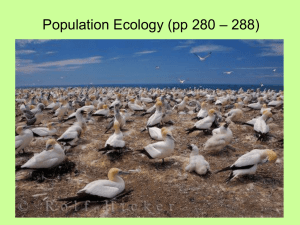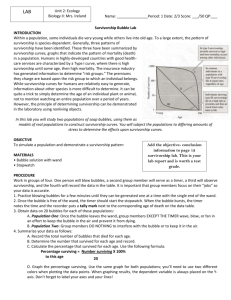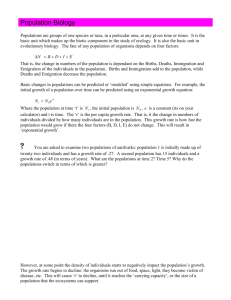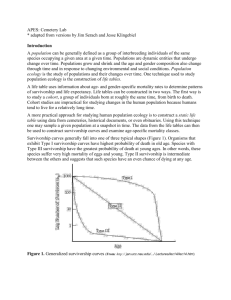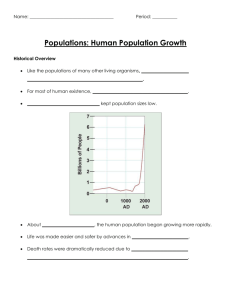survivorship curves (1) - IB
advertisement
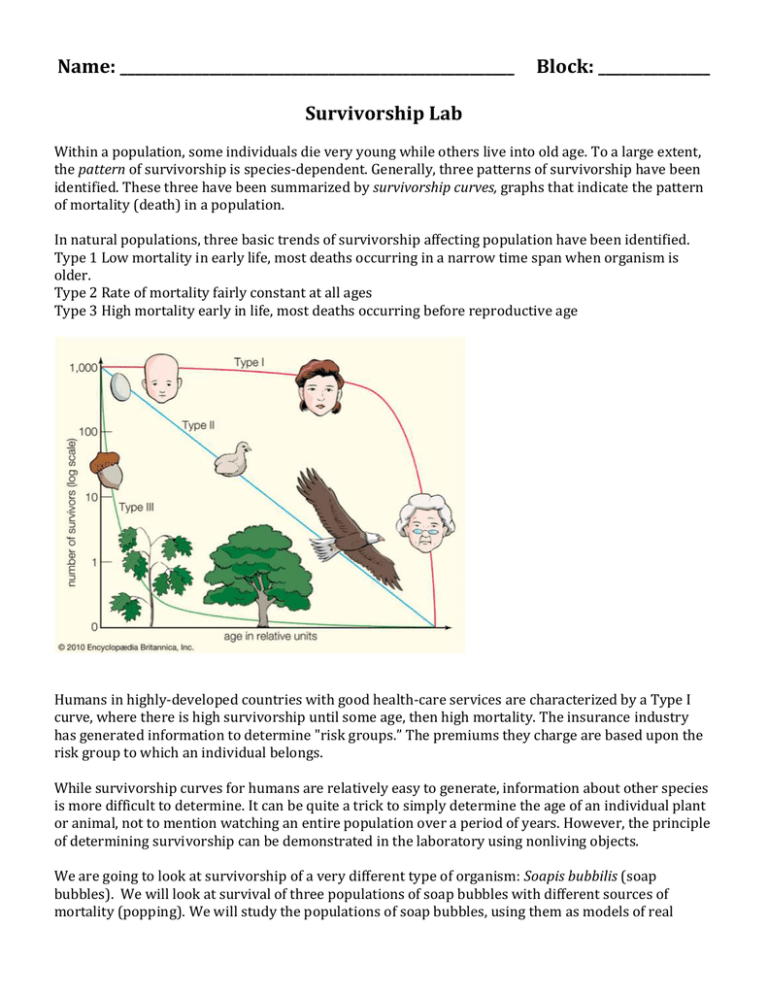
Name: _____________________________________________________ Block: _______________ Survivorship Lab Within a population, some individuals die very young while others live into old age. To a large extent, the pattern of survivorship is species-dependent. Generally, three patterns of survivorship have been identified. These three have been summarized by survivorship curves, graphs that indicate the pattern of mortality (death) in a population. In natural populations, three basic trends of survivorship affecting population have been identified. Type 1 Low mortality in early life, most deaths occurring in a narrow time span when organism is older. Type 2 Rate of mortality fairly constant at all ages Type 3 High mortality early in life, most deaths occurring before reproductive age Humans in highly-developed countries with good health-care services are characterized by a Type I curve, where there is high survivorship until some age, then high mortality. The insurance industry has generated information to determine "risk groups.” The premiums they charge are based upon the risk group to which an individual belongs. While survivorship curves for humans are relatively easy to generate, information about other species is more difficult to determine. It can be quite a trick to simply determine the age of an individual plant or animal, not to mention watching an entire population over a period of years. However, the principle of determining survivorship can be demonstrated in the laboratory using nonliving objects. We are going to look at survivorship of a very different type of organism: Soapis bubbilis (soap bubbles). We will look at survival of three populations of soap bubbles with different sources of mortality (popping). We will study the populations of soap bubbles, using them as models of real populations to construct survivorship curves. We will subject these populations to different kinds of stress to determine the effects upon survivorship curves. Materials bubbles stopwatch/phone timers rulers calculator graph paper – logarithmic survivorship frame Procedure: Soap Bubble Survivorship Work in groups of three for this experiment. One person will blow bubbles, a second member will serve as the timer, a third observes survivorship (calls out when the bubble bursts), and the timekeeper records data in your data tables. Three different populations of soap bubbles will be formed based upon actions of group member: Population A (Nuturing) - once the bubble leaves the wand, group members wave, blow, or fan in an effort to keep the bubble in the air and prevent it from breaking (“dying”). Population B (Sink or Swim babies)- group members do nothing to interfere with the bubbles or keep them in the air. Population C (Making it to Maturity) - this group requires a line one meter from the bubble blower. The group member blowing the bubbles tries to blow the bubbles through the opening in the frame. Bubbles that don’t cross the line “die” at 1 second. Bubbles that cross the line are timed until they pop/die. Group members cannot do anything to influence the bubbles survival. a. Bubbles that burst prior to passing through the frame are included in the data. (These bubbles died as “children”.) b. Bubbles that burst hitting the frame are included in the data. (These bubbles died as “adolescents”). c. Bubbles that fall without passing through the frame ARE NOT INCLUDED! d. Bubbles that burst after passing through the frame are included. (These bubbles died as “adults”.) https://www.youtube.com/watch?v=C3YyzS_QSlE - explanation of the 3 experimental setups. Fill out three data tables, one for each population. They should be set up in the following format: 1. Practice blowing bubbles for a few minutes until they can be generated with the single end of the wand. 2. Once the bubble is free of the wand, the timer should start the watch. When the bubble bursts, the timer should note the time and puts a check mark next to the appropriate “age at death” in the data table for the appropriate population. 3. Obtain data on 50 bubbles. 4. Repeat the entire procedure above for each of the three soap bubble populations, making the modifications necessary that are described earlier. 5. Organize your data as follows: a.. Count the number of bubbles dying at each age. Record this number as New Deaths b. Add new deaths to your previous Total Dying, to find the current Total Dying for each time. For example if five died at 1 second, then Total Deaths is 5. If two more died at 3 seconds, your Total Deaths would be 7 (5 + 2). c. Subtract Total Deaths from 50 to determine the number of surviving at each age. Using the above example: at 1 second, 45 survived, and at 3 seconds 43 survived. d. Calculate the percentage surviving at each age. Since birth (moment the bubble left the wand) fifty bubbles were alive, 100% were alive at time zero seconds. Use the following formula: % surviving = (# surviving/50) x 100. 6. Using the above example: at 1 second, 90% survived, and at 3 seconds 86% survived. C. Plotting Survivorship Curves In order to analyze what type of curve your populations’ experience, you will need to graph your data. We will do two types of graphing: a normal survivorship and a log survivorship table. You will plot your data on both the normal linear graph and the log graph. Pay careful attention to the numbering. Each line still represents 1/10 of the distance to the next number. For example: 2% is still the next division after 1%. The x axis is still a normal axis with ‘time’ in seconds. We plot survivorship curves on semi-log graphs because lx is a proportion: the proportion of the original cohort surviving to age x. The distance between points on a logarithmic axis reflects their proportional relationship, and so a logarithmic scale is appropriate. It is easier to see details for very small and very large values of y. This kind of graph also makes clear important differences between the three types of survivorship curve. Note that on the linear graph, type II and type III curves have qualitatively similar shapes, whereas on the semi-log graph they look quite different. Using a semi-log grid, the spacing automatically takes into account the effect of a log on the graph and “calculates” the logarithm of the percentage surviving for you. D. Interpretation of the Survivorship Curves A straight line on the logarithmic plot indicates the death rate is constant. In the arithmetic plot it is easier to see that more individuals die at a young age than at older ages. In natural populations, three basic trends of survivorship affecting population size have been identified. These are represented in the table and semi-log graph below. NOTE- In analyzing a population survivorship trend, the semi-log plot must be used. Survivorship Curves I Low mortality early in life, most deaths occurring in a narrow time span at maturity II Rate of mortality fairly constant at all ages III High mortality early in life Questions (to be answered on a separate sheet of paper). 1. Examine the survivorship curves for the three soap bubble populations. How do they correlate with the Type I, II, and III survivorship trends? Explain. 2. Do any of the bubble populations show constant death rate for at least part of their lifespan? If so, which? 3. How did the treatments that bubble populations 1, 2, and 3 were subjected to affect the shape of their curves? 4. Which type of survivorship curve describes a population of organisms that produces a very large number of offspring, most of which die at a very early age, only a few surviving to old age? Give an example of a population of this type. 5. What reproductive strategy (R or K) would you expect each population to have. Explain each of these strategies. 6. Would you expect a population in which most members survive for a long time to produce few or many offspring? Which would be most advantageous to the population as a whole? Explain. 7. Suppose a human population exhibits a Type III survival curve. What would you expect to happen to the curve over time if a dramatic improvement in medical technology takes place? Explain. 8. What would you expect to happen to a population where the birth rate is about equal to the death rate? Explain. 9. How many humans presently occupy our planet? [look it up] 10. Is our population increasing, decreasing, or remaining stable? Explain with evidence. 11. Give an example of an organism that exhibits each type of survivorship curve? 12. Some survivorship curves are actually “stair-stepped”. What would a graph of this shape indicate? Identify an organism whose life span would illustrate this type of curve. 13. Since the 1960s, the human population has been steadily expanding. Though ‘r’ is decreasing with people having fewer offspring, we may yet overshoot our carrying capacity. What would happen to our population? Give some examples. What part of the carrying capacity most affects people? 14. It’s the year 2525, and the human race can travel quickly and easily between the stars and planets. While out exploring the universe one day, you discover a new planet that is essentially identical to Earth, except the planet has no humans, cities, or constructs of any kind. Otherwise, the planet has all the same wildlife, plants, geographical features, and climate. A few years later, your superiors tell you that they have found many thousands of volunteers who are eager to inhabit this new planet. It is your job to organize the initial colonization of this new planet. Where on this “earth” would you start your colony? Why have you chosen your particular location? Would you colonize in several different locations or just one? What factors entered into your decision? What kind of age structure and sex ratio would you want to start with? Why? What is likely to happen to the human population once it becomes established in your location? What kind of growth and growth rate will the new population exhibit? After several years, how will its growth rate, survivorship, and age structure change? Turn in your data tables, graphs and answers to questions stapled together in this order.


